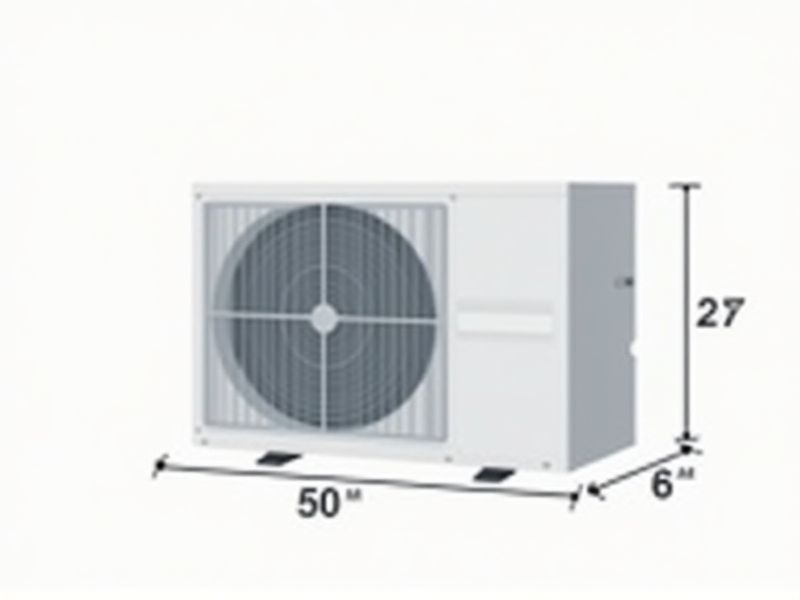
When selecting an air conditioner, understanding its standard dimensions can help ensure a proper fit for your space. For window air conditioners, typical sizes range from 18 to 26 inches in width, 12 to 18 inches in height, and 15 to 25 inches in depth. Split air conditioner indoor units generally measure between 32 to 45 inches wide, 10 to 14 inches high, and 7 to 12 inches deep, while outdoor units are larger, often about 30 to 40 inches wide, 20 to 30 inches high, and 10 to 16 inches deep. Always refer to manufacturer specifications and measure your installation area before purchasing to ensure compatibility.
Physical Size And Coverage Area
When selecting an air conditioner, consider the physical size, which often corresponds to its cooling capacity measured in BTUs (British Thermal Units). For optimal performance, an air conditioner should typically cover an area of 20 BTUs per square foot; for example, a 700-square-foot room would require a unit with at least 14,000 BTUs. Additionally, the size of the air conditioning unit should fit the available space without overcrowding to ensure efficient airflow and cooling. Always check the manufacturer's specifications to ensure your chosen model aligns with the specific coverage area needed for your environment.
Cooling Capacity And Btu Rating
The cooling capacity of an air conditioner is primarily measured in British Thermal Units (BTU), which quantifies the amount of heat the unit can remove from the air in one hour. For residential spaces, a common recommendation is approximately 20 BTU per square foot, ensuring optimal comfort and efficiency. A typical 1.5-ton air conditioner can provide around 18,000 BTU, suitable for rooms between 800 to 1,200 square feet. Choosing the right BTU rating is crucial for maintaining energy efficiency and avoiding overworking your system, which can lead to increased energy bills and reduced lifespan of the unit.
Installation Space And Clearance
Air conditioners require specific installation space and clearance to operate efficiently. Ideally, a minimum clearance of 12 to 24 inches should be maintained around the air conditioning unit to ensure proper airflow and prevent overheating. For wall-mounted units, ensure that the installation area allows for at least 6 inches of space above the unit and a minimum of 2 feet from any obstructions to optimize performance. Ensuring that these guidelines are followed can significantly enhance your air conditioner's longevity and efficiency.
Airflow Direction And Distribution
Airflow direction and distribution in air conditioners are critical for maintaining optimal indoor climate control. A well-designed system ensures that airflow reaches all areas of a room, providing uniform temperature and comfort, which can improve energy efficiency by up to 20%. Adjustable louvers and diffusers play a significant role in directing air, allowing you to customize the airflow according to your needs. Proper airflow not only enhances cooling or heating performance but also contributes to better indoor air quality by reducing the accumulation of allergens and pollutants.
Wall Or Window Fitting Dimensions
Air conditioners designed for wall or window fitting are typically manufactured to specific dimensions to ensure a proper fit and optimal performance. Standard sizes can range from approximately 24 to 42 inches in width and 15 to 20 inches in height, accommodating various window openings. Many units also come with adjustable side panels, allowing for a snug fit in openings that may vary slightly in size. Choosing the right dimensions not only enhances energy efficiency but also ensures that your space remains comfortable and well-cooled during peak summer months.
Electrical Requirements And Voltage
Air conditioners typically operate on standard voltages of 120V or 240V, with residential units often using the former. The electrical requirements play a critical role in ensuring optimal performance; for example, a 1.5-ton central air conditioning unit generally consumes about 3,500 watts. You should also consider the amperage; a typical 240V unit might draw between 15 to 30 amps, depending on its size and efficiency rating. Proper circuit breakers and wiring must be installed to support these electrical demands to ensure safety and functionality.
Noise Level And Decibel Rating
When selecting an air conditioner, it's crucial to consider the noise level, typically measured in decibels (dB). Most modern models operate between 40 dB to 60 dB; for reference, a quiet library registers around 40 dB, while a normal conversation is about 60 dB. A unit with a rating below 50 dB is ideal for bedrooms or quiet areas, providing comfortable cooling without disruptive noise. Checking the manufacturer's specifications ensures that you choose an air conditioner that meets your preferences for both performance and tranquility.
Drainage And Condensation Flows
The efficiency of air conditioners heavily relies on effective drainage and condensation management, which ensures optimal cooling performance. A well-designed drainage system should handle condensation flow rates of approximately 1 to 2 gallons per hour, depending on humidity levels. Improper drainage can lead to water pooling, potentially damaging the unit and your property. Regular maintenance, including clearing drainage lines, is essential to prevent clogs and maintain peak efficiency, ensuring your air conditioning system operates as intended for years.
Weight Limits And Support Structure
The weight limit for air conditioners typically ranges from 30 to 300 pounds, depending on the model and its capacity. Proper support structures are crucial, as they must withstand the unit's weight while ensuring safety and efficiency in operation. For instance, residential air conditioning systems often require reinforced brackets or platforms that can handle at least 1.5 times the unit's weight. Ensuring your installation meets these standards is key to maximizing performance and preventing maintenance issues.
Maintenance Access And Filter Size
When selecting an air conditioner, prioritize maintenance access and filter size for optimal performance and efficiency. A unit designed with easy access points allows for hassle-free regular servicing, which can extend its lifespan. The filter size is crucial; larger filters typically capture more dust and allergens, improving indoor air quality significantly. For your convenience, many modern units feature washable filters that require less frequent replacement, saving you time and money.
